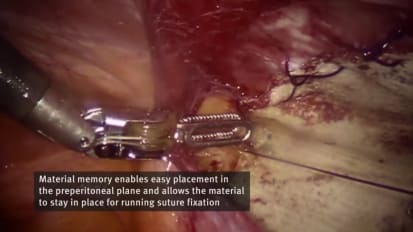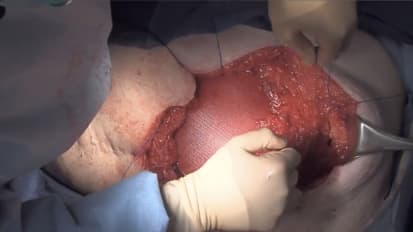
 Video
Video
Laparoscopic Fixation of GORE® SYNECOR Biomaterial in a Cadaver Model Using a Robotic Arm
Erik B. Wilson M.D., FACS, shares a video showing laparoscopic fixation of GORE® SYNECOR Biomaterial in a cadaver model using a robotic arm. Video
Video
Robotic Preperitoneal Umbilical Hernia Repair
Robotic preperitoneal repair of an umbilical hernia utilizing GORE® SYNECOR Preperitonal Biomaterial by Matthew R. Reynolds, D.O. Video
Video
Ventral Hernia Repair Using the Components Separation Technique
Brent Mathews, M.D., FACS, performs a ventral hernia repair using the components separation technique. Document
Document
The Role of a Biosynthetic Hybrid Mesh in Abdominal Wall Hernia Repair in High-Risk Patients with Multiple Comorbidities
The influx of more high-risk and obese patients in need of abdominal wall hernia repair naturally leads to larger, more complex hernia cases and the need for strong mesh. Document
Document
Virtual Case Study - Matthew Goldblatt, M.D., FACS: Visible tissue responsiveness: Metabolic and fibroblast activity during utilization of a bioabsorbable matrix in abdominal wall reconstruction
Visible tissue responsiveness: Metabolic and fibroblast activity during utilization of a bioabsorbable matrix in abdominal wall reconstruction Document
Document
Biosynthetic Tissue Scaffold Recruits Progenitor Cells in Muscle Tissue Healing Model
This study demonstrates that the open, porous structure of the GORE® BIO-A® Tissue Reinforcement is able to recruit the Pax7+ cells residing in host muscle, a critical step in muscle regeneration. Document
Document
Case Study: Proven Outcomes Reduced Costs for Complex Hernia Repairs
GORE® BIO-A® Tissue Reinforcement is an excellent choice in soft tissue repair, including complex hernia. Document
Document
Mesh Selection for Hernia Repair: Expert Review of Biologic, Synthetic and Bioabsorbable Types
Today, mesh closure is the standard in hernia repair, a credit to advances in materials and surgical techniques since usher.